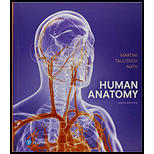
Concept explainers
Match each numbered item with the most closely related lettered item.
no movement............
To review:
Match the term no movement with the most closely related description given below:
Wrist joint
Dorsiflexion
Fluid-filled pockets
Diarthrosis
Knee
Intervertebral discs
Supination
Extension
Synarthrosis
Introduction:
The junctions at which two or more bones joins is known as joints. It is also termed as articulations. The function, as well as, the range of motion is determined by the anatomy of the particular joint.
Explanation of Solution
The joints, on the basis of their range of motion, are classified into three groups. The immovable joints are known as synarthrosis. The joints, which are slightly movable, are called amphiarthrosis. The joints that can move freely are termed as diarthrosis.
Therefore, it can be concluded that the term no movement can be correctly matched with option (i) synarthrosis.
Want to see more full solutions like this?
Chapter 8 Solutions
Human Anatomy (9th Edition)
- Provide the anatomical term that correctly names each of the following body regions: (a) arm, (b) thigh, (c) chest, (d) fingers and toes, (e) anterior aspect of the knee.arrow_forwardIndicate if each of the following sentences makes correct or incorrect usage of the word in boldface type (assumethat the body is in the anatomical position). If the sentence is incorrect, supply a term that will make it correct in thespace provided. 7. The hand is proximal to the elbow....................................arrow_forwardplease help me with t........his questionss!!!arrow_forward
- The deep inguinal ring is formed from which of the following? (A) transversalis fascia (B) peritoneum (C) connective tissue of the transversus abdominus muscle (D) connective tissue of the internal abdominal oblique (E) connective tissue of the external abdominal obliquearrow_forwardTendons attach muscles to bones. Tendons are extensions of the: a)epimysium. b)perimysium. c) endomysium. d) fascia.arrow_forward...... Please answer the question below ..arrow_forward
- Indicate if each of the following sentences makes correct or incorrect usage of the word in boldface type (assumethat the body is in the anatomical position). If the sentence is incorrect, supply a term that will make it correct in thespace provided.1. The mouth is superior to the nose....................................arrow_forwardDefine the following terms: (a) Aestivation (b) Placentation (c) Actinomorphicarrow_forwardWhich muscle is found within the spermatic cord? Oa) Bulbospongiosus b) Cremaster OC) Dartos O d) Ishiocavernosusarrow_forward
- A woman was hit by a car and complained of injuries to her leg, knee, hip, and thigh. She was taken to the nearest hospital, where, on the orders of a physician, she received X-rays of her arm and pelvis. No X-ray was taken of her leg, and she was released from the hospital on crutches. The pain in her leg increased, and she went to another hospital some hours later, where an X-ray was taken and revealed that her leg was fractured. She was admitted to the second hospital and remained an inpatient for a month. Ten days after admission to the second hospital, she received a letter from the first hospital telling her to return for a leg X-ray. She sued the first hospital and the radiologist. Does the radiologist, who never saw her, have a contractual relationship with the patient?arrow_forwardA woman was hit by a car and complained of injuries to her leg, knee, hip, and thigh. She was taken to the nearest hospital, where, on the orders of a physician, she received X-rays of her arm and pelvis. No X-ray was taken of her leg, and she was released from the hospital on crutches. The pain in her leg increased, and she went to another hospital some hours later, where an X-ray was taken and revealed that her leg was fractured. She was admitted to the second hospital and remained an inpatient for a month. Ten days after admission to the second hospital, she received a letter from the first hospital telling her to return for a leg X-ray. She sued the first hospital and the radiologist. Does the radiologist, who never saw her, have a contractual relationship with the patient? I believe the radiologist does have a contractual relationship with the patients because they are the one reading the X-rays and making the diagnosis to the doctor. The patient was right in suing the hospital…arrow_forwardHelp me for fill out.....arrow_forward
 Human Anatomy & Physiology (11th Edition)BiologyISBN:9780134580999Author:Elaine N. Marieb, Katja N. HoehnPublisher:PEARSON
Human Anatomy & Physiology (11th Edition)BiologyISBN:9780134580999Author:Elaine N. Marieb, Katja N. HoehnPublisher:PEARSON Biology 2eBiologyISBN:9781947172517Author:Matthew Douglas, Jung Choi, Mary Ann ClarkPublisher:OpenStax
Biology 2eBiologyISBN:9781947172517Author:Matthew Douglas, Jung Choi, Mary Ann ClarkPublisher:OpenStax Anatomy & PhysiologyBiologyISBN:9781259398629Author:McKinley, Michael P., O'loughlin, Valerie Dean, Bidle, Theresa StouterPublisher:Mcgraw Hill Education,
Anatomy & PhysiologyBiologyISBN:9781259398629Author:McKinley, Michael P., O'loughlin, Valerie Dean, Bidle, Theresa StouterPublisher:Mcgraw Hill Education, Molecular Biology of the Cell (Sixth Edition)BiologyISBN:9780815344322Author:Bruce Alberts, Alexander D. Johnson, Julian Lewis, David Morgan, Martin Raff, Keith Roberts, Peter WalterPublisher:W. W. Norton & Company
Molecular Biology of the Cell (Sixth Edition)BiologyISBN:9780815344322Author:Bruce Alberts, Alexander D. Johnson, Julian Lewis, David Morgan, Martin Raff, Keith Roberts, Peter WalterPublisher:W. W. Norton & Company Laboratory Manual For Human Anatomy & PhysiologyBiologyISBN:9781260159363Author:Martin, Terry R., Prentice-craver, CynthiaPublisher:McGraw-Hill Publishing Co.
Laboratory Manual For Human Anatomy & PhysiologyBiologyISBN:9781260159363Author:Martin, Terry R., Prentice-craver, CynthiaPublisher:McGraw-Hill Publishing Co. Inquiry Into Life (16th Edition)BiologyISBN:9781260231700Author:Sylvia S. Mader, Michael WindelspechtPublisher:McGraw Hill Education
Inquiry Into Life (16th Edition)BiologyISBN:9781260231700Author:Sylvia S. Mader, Michael WindelspechtPublisher:McGraw Hill Education





